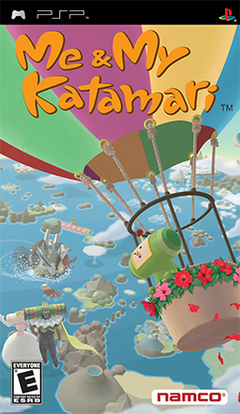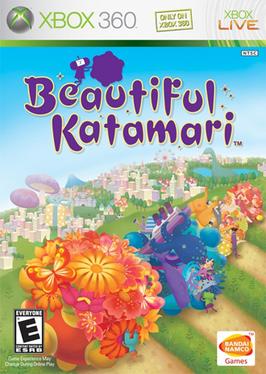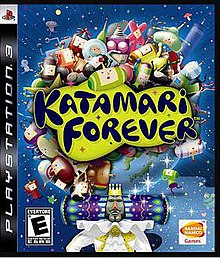
Katamari Damacy is a third-person puzzle-action video game developed and published by Namco for the PlayStation 2. It was released in Japan in March 2004 and later in North America in September. Designer Keita Takahashi struggled to pitch the game to Namco's superiors, eventually seeking student aid from the Namco Digital Hollywood Game Laboratory to develop the project for less than US$ 1 million. As director, Takahashi emphasized concepts of novelty, ease of understanding, and enjoyment.

Taiko: Drum Master, also known as Taiko no Tatsujin: Taiko Drum Master in Japan, is a rhythm game developed and published by Namco for the Sony PlayStation 2 as part of the popular Japanese video game franchise Taiko no Tatsujin. It was released in North America in 2004, and Japan in 2005.

We Love Katamari is a 2005 third-person puzzle-action video game developed and published by Namco for the PlayStation 2. It is the sequel to the 2004 sleeper hit Katamari Damacy. The player controls a diminutive character named the Prince as he rolls around an adhesive ball called a "katamari" to collect increasingly larger objects, ranging from coins to pencils to buildings, in order to build stars as ordered by his father, the King of All Cosmos.

Pac-Attack, also known as Pac-Panic, is a 1993 falling-tile puzzle video game developed and published by Namco for the Super Nintendo Entertainment System and Sega Genesis. Versions for the Game Boy, Game Gear and Philips CD-i were also released. The player is tasked with clearing out blocks and ghosts without them stacking to the top of the playfield — blocks can be cleared by matching them in horizontal rows, while ghosts can be cleared by placing down a Pac-Man piece that can eat them. It is the first game in the Pac-Man series to be released exclusively for home platforms.

Keita Takahashi is a Japanese game designer and artist, his most notable titles being Katamari Damacy and its sequel, We Love Katamari. The original Katamari game was a surprise hit and was praised for its quirkiness, originality, and charm. Takahashi is married to pianist and composer Asuka Sakai, who has worked with Takahashi on various projects.

Me & My Katamari is a 2005 third-person puzzle-action video game developed and published by Namco for the PlayStation Portable. It is the third game in the Katamari series, the first game on a portable system and the first game produced without the involvement of series creator Keita Takahashi. It is also the last Katamari game to be published by Namco as an independent company, having merged with Bandai earlier in 2005.
Yuu Miyake is a Japanese composer and sound engineer who formerly worked at Bandai Namco Entertainment. His most known work surfaced with Katamari Damacy soundtracks, on which he served as a sound director. Other notable works include various tracks in the Tekken and Ridge Racer series.

Dynasty Warriors: Gundam, originally released in Japan as Gundam Musou, is a 2007 video game based on the Gundam anime series. It was developed by Omega Force and published by Namco Bandai Games. Its gameplay is derived from Koei's Dynasty Warriors and Samurai Warriors series. The "Official Mode" of the game is based primarily on the Universal Century timeline, with mecha from Mobile Suit Gundam, Mobile Suit Zeta Gundam, and Mobile Suit Gundam ZZ appearing in the game, as well as a few units from Mobile Suit Variation and Mobile Suit Gundam 0083: Stardust Memory appearing as non-playable enemy units. The "Original Mode" of the game also features mecha from the non-UC series Mobile Fighter G Gundam, Mobile Suit Gundam Wing and Turn A Gundam. A newly designed non-SD Musha Gundam designed by Hajime Katoki is also included.

Beautiful Katamari, released in Japan as Beautiful Katamari Damacy, is a video game by Namco Bandai Games for the Xbox 360. Beautiful Katamari is the fourth game in the Katamari series of games following Katamari Damacy, We Love Katamari, and Me & My Katamari.
Katamari Damacy Mobile was a video game developed by Namco Bandai Games for the Mitsubishi P904i series of mobile phones for NTT Docomo. It was released in June 2007 in Japan. It is a spin-off of the Katamari Damacy series, the second game on a handheld game console and the third game produced without the involvement of series creator Keita Takahashi.
Masayuki Tanaka is a Japanese singer. He was born in Imari, Saga Prefecture. He is one of the two original vocalists of the band Crystal King, known for their anime soundtracks such as Fist of the North Star where Tanaka provided the vocals in the chorus of its opening theme. After leaving Crystal King, he started his solo career and along the line lost his voice after being struck in the throat by a baseball and was never able to regain his original vocal range. In the late 1990s and early 2000s, he worked on the soundtracks of the tokusatsu series Ultraman Gaia and Kamen Rider Kuuga. He is also featured on the Katamari Damacy soundtrack Katamari Fortissimo Damacy where he sings "Katamari on the Rock", the main theme of the game.

Top Spin 3 is the third title in the Top Spin series of video games. The game was developed by PAM Development and published by 2K. New game elements include real-time weather effects, more options of professional tennis players, an in-depth character creation tool and new unparalleled gameplay mechanics. It also features impressive advancements in an audio/visual sense with improved Dolby Digital surround sound and "Evolutionary" visuals. Top Spin 4 was released as a sequel about three years later.

NOISE Inc. is a Japanese video game development company that works in partnership with Nintendo, developing games for the Custom Robo series.

I Love Katamari was a third-person puzzle-action video game developed by Namco Bandai Games for iOS. It is a continuation of the Katamari Damacy series of games. It was released worldwide in the App Store on December 14, 2008. A Windows Phone 7 version of the game was released in 2010. The version for Android was released in 2012 exclusively for Samsung Android devices. In this game, the King of All Cosmos instructs the game's protagonist – the Prince – to gather as many objects as possible to grow a highly adhesive ball called a Katamari large enough so that he can pick up special objects to bring to the King so that he can regain his memory.

NHL 2K10 is an ice hockey sports video game developed by Visual Concepts and published by 2K, part of the NHL 2K series. It was released on September 15, 2009 for PlayStation 2, PlayStation 3, Wii, and Xbox 360. Randy Hahn and Drew Remenda provide commentary as they did for NHL 2K9. NHL 2K10 was the final 2K Sports ice hockey video game to be released for the PlayStation 2, PlayStation 3, and Xbox 360, as NHL 2K11 was released only for the iOS and Wii.
Katamari Damacy is a third-person puzzle-action video game that was published and developed by Namco for the PlayStation 2 video game console. The success of the game led to the release of six sequels in Japan and other territories: We Love Katamari, Me & My Katamari, Beautiful Katamari, Katamari Damacy Mobile, I Love Katamari, and Katamari Forever. It also inspired a spin-off game, Korogashi Puzzle Katamari Damacy.

Star Trigon is a 2002 puzzle arcade game published in Japan by Namco. Ports for iPod, iOS devices and Windows were also released. In the game, the player controls one of three characters — Wataru Hoshi, Chuta Bigbang and Susumu Hori — the objective being to rescue creatures known as "Uchijins" by hopping from planet to planet to draw triangles and capture them. The player will automatically circle the planet they are on, requiring timed jumps to avoid falling off the playfield. It ran on the Namco System 10 hardware.

Katamari is a Japanese video game franchise created by Keita Takahashi and developed and published by Namco. The series puts players in control of a young character called The Prince as he assists his father, the King of All Cosmos, in the re-creation of stars and planets by using a ball called a katamari to roll up objects. The first title in the series was Katamari Damacy for the PlayStation 2, which became a cult classic and led to several sequels and spin-offs.

Katamari Amore was a third-person puzzle-action video game published and developed by Namco Bandai Games for iOS. The game was revealed in a pre-release state at E3 2011, and was released to the public on September 29. Katamari Amore is the second game of the Katamari franchise to be released on iOS, and it featured Game Center integration.

Touch My Katamari, known in Japan as Katamari Damacy No-Vita, is a video game in the Katamari series. It was developed by Namco Bandai Games for the PlayStation Vita and was released as a launch game in Japan on December 17, 2011 and in Europe and North America on February 22, 2012.















